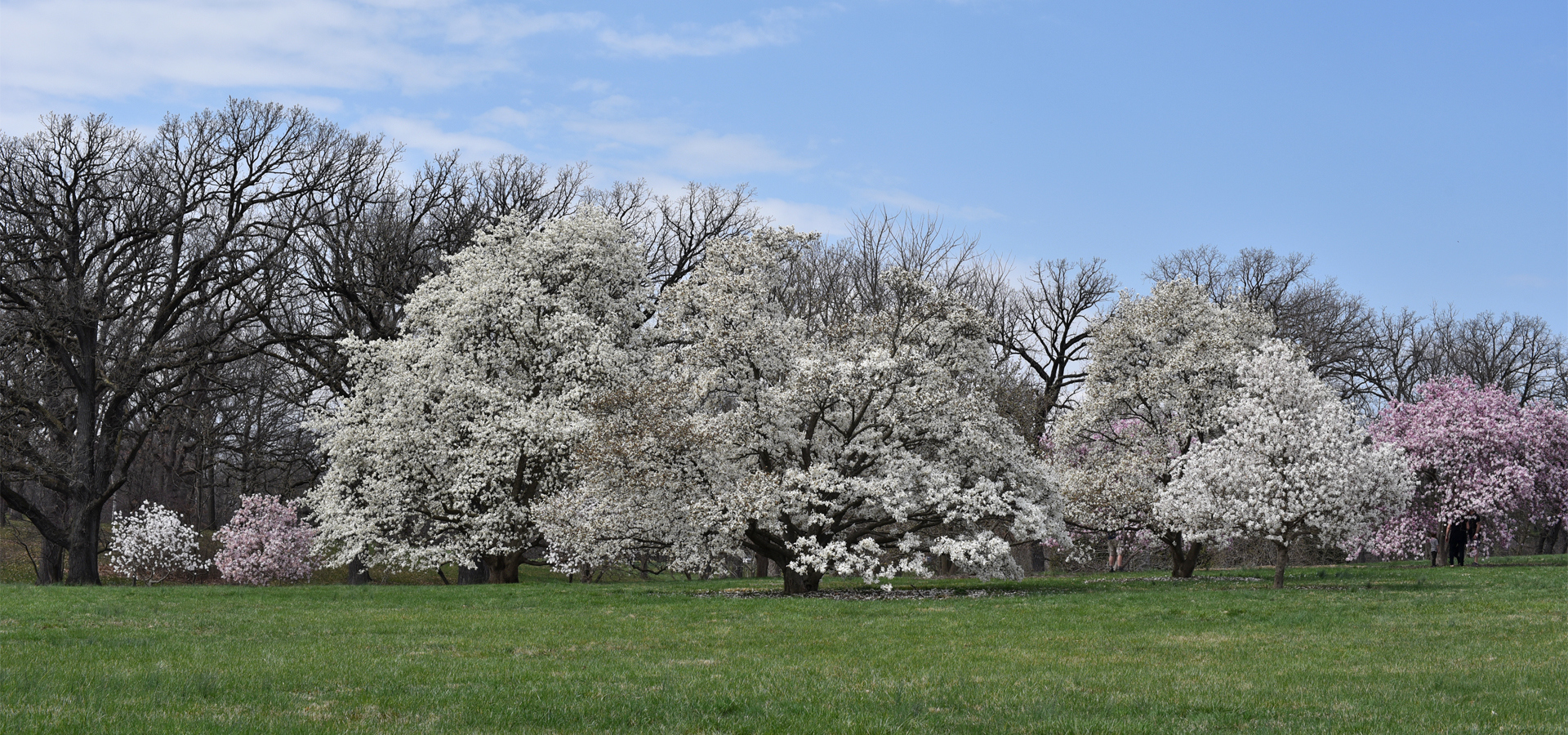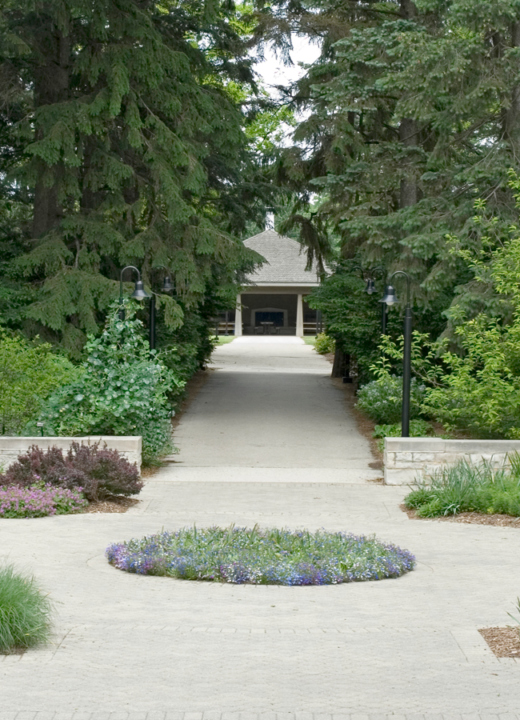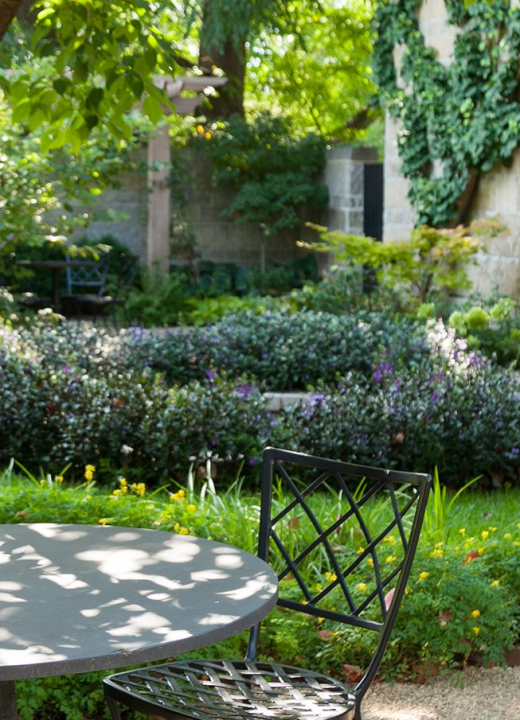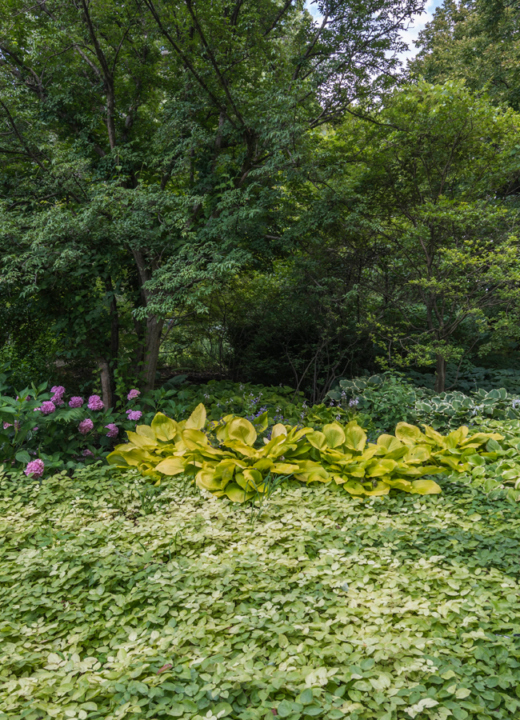The ornamental flowering trees collection at The Morton Arboretum showcases the most ornamental trees: crabapples, magnolias, pear, serviceberry, buckeye, horsechestnut, and dogwood, famous for their amazing floral displays and perfumed scents. Visit in spring, when the entire hillside is festooned in flowers.
The area of Ornamental Flowering Trees is located on the West Side of the Arboretum, at the beginning of the Main Route leading to the Thornhill Education Center. This south-facing hill was the original site where 200 crabapple cultivars were assembled for a crabapple (Malus) evaluation program in 1980. Today, the Arboretum continues to evaluate a broad range of ornamental flowering trees. Many disease-resistant and highly ornamental varieties are featured. In this area you will also see a beautiful array of pear (Pyrus) and magnolia (Magnolia). Homeowners can view a variety of ornamental trees in one place to get ideas for a suitable tree for their yard.
All of the featured specimens are genera loved for their showy and often fragrant flowers during spring or ornamental fruits in the fall. Take a walk through this area in spring or fall for an experience that will dazzle your senses.
Crabapples
Crabapples (Malus) are the most stunning spring-flowering trees for Midwest landscapes. Not only are most crabapples small trees, making them an appropriate size for most home gardens, but their spring blooms are so prolific and showy one can’t help but love these trees. They are exciting throughout the year, with craggy branches and persistent fruits in winter.
About 55 different species are in the genus Malus, and innumerable cultivars are available in the landscape trade. The Morton Arboretum’s Crabapple Collection was started in 1924. Part of this collection on the West Side participated in the National Crabapple Evaluation Program, which evaluated new and disease-resistant varieties. As a result of the multiyear evaluation and additions, the West Side Malus Collection now contains 60 different kinds and over 140 specimens with highly desirable qualities. The Morton Arboretum also has a crabapple collection on its East Side.
Some of the specimens in this collection are almost large enough to be considered shade trees, while others are quite small. Shapes vary as well, from wide to upright and narrow, weeping, and multi-stemmed. Flower color ranges from white to pink, red, purple, and crimson. Some flower buds will be one color, and then open up to a completely different color. Fruits range in size from smaller than a pea to nearly the size of most apples; they can be red, purple, orange, yellow, or green. Some of the smaller fruits persist on the tree throughout winter, providing a splash of color in the cold months.
If you love crabapple trees, take a trip to the East Side of the Arboretum to the collection surrounding Crabapple Lake, located near Parking Lot 5.
Magnolias
Magnolias (Magnolia) have the largest flowers of any of the trees cold-hardy to this region. They provide an amazing opportunity for large flowers, large leaves, and exotic scents to be a part of any garden. Additionally, their blooms can be found in a great diversity of colors, from creamy white to purple to yellow.
Renowned plant collector E.H. Wilson once said that “magnolias are aristocrats of ancient lineage possessed of many superlative qualities.” The richly scented flowers of some species are enormous, the largest flowers of all cold-hardy flowering trees. Their colors range from creamy white to magenta-purple to yellow.
The Morton Arboretum exhibits 49 different kinds of hardy magnolia specimens. Among these trees are early blooming Asian species and their hybrids. For example, Merrill Loebner’s magnolia (Magnolia x loebneri ‘Merrill’), northern Japanese magnolia (Magnolia kobus), and star magnolia (Magnolia stellata) may bloom in early- to mid-March.
A very interesting magnolia is bigleaf magnolia (Magnolia macrophylla). With its three-foot-long leaves, this Appalachian native has the largest leaf of all temperate deciduous trees. Look for the Asian counterpart of bigleaf magnolia in the China Collection and be amazed at how closely they resemble one another. Perhaps the most exciting trees in the collection are the yellow-flowering magnolias. You will find the cultivars ‘Butterflies’, ‘Elizabeth’, ‘Yellow Fever’, and ‘Limelight’. The yellow magnolias are new and different from many other magnolias. These cultivars bloom mid- to late-May, reducing their chances of frost damage.
If you love magnolia trees, take a trip to the East Side of the Arboretum to the collection of magnolias and related plant families (Magnoliidae) located near Parking Lot 4.
Pear
Like crabapples, pear trees also bloom with showy flowers in spring. Pears (Pyrus) are generally medium-sized trees, making them useful in a variety of landscape situations. Visit this collection in spring and in the fall, as many of these trees have incredibly vibrant fall color.
Pear trees are in the genus Pyrus, of the Rose Family (Rosaceae). Pyrus are native to the temperate regions of Europe, northern Africa, and Asia. Because ornamental pears are medium-sized trees that often have a tall narrow crown, white showy flowers, and rich fall color, they are always popular landscape trees.
The Morton Arboretum’s collections are just north of the crabapples on the West Side, and are also found in the Pyrus section of the Rose Family Collection on the East Side. The two collections exhibit 24 different kinds of pears. Ussurian pear (Pyrus ussuriensis) was one of the first specimens to be planted in 1922. It has now reached maturity and exhibits a wide crown. Look for the very old weeping willow-leaved pear (P. salicifolia ‘Pendula’). This species is special for its very narrow lanceolate leaves that are covered in silvery hairs.
A great time to visit this collection is in spring, when the trees are bursting with pale white flowers. The collection will be abuzz with insects pollinating these grand trees.





























































































